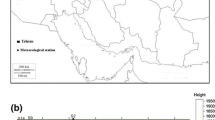Abstract
Estimates of reference evapotranspiration (ETo) are widely used in irrigation engineering to define crop water requirements. A major drawback to application of the FAO Penman-Monteith is the relatively high data demand which unfortunately, for many locations; such meteorological variables are often incomplete and/or not available. Alternatively, the Blaney–Criddle (BC) equation is a simpler method for ETo estimation. In this study, the BC equation was calibrated using three methods: spatially calibration at each station for the whole period (ETo-BCS); two periods calibration (ETo-BCS2); and spatial and temporal calibration at each station for each month (ETo-BCS,T) using twelve stations a cross Jordan. The calibration coefficient of BC equation (a, b) were determined at all stations. The results of the calibration methods showed that: (1) the spatial calibration of BC had the highest RMSE, and ME and Lower R2 comparing to spatial and temporal calibration and two periods calibration. (2) Improvement was achieved for the BC equation when considering the spatial and temporal calibration for all months at each station. The values of a were negative for all months of any station. The higher values of a are coincided with cold or low temperature months while the high values coincided with high month temperature. The b values were positive for the whole stations and months. As the a values, it seems that b values had higher values in warm months than the cold one. A relatively good improvement could be obtained using two periods calibration instead of one period. The maps of a and b clearly show that a and b varied considerably in the study area and being aware of the spatial temporal variations of climatologically parameters is important in managing the limited water resources. Knowing the spatial temporal changes of such parameters, accurate calculations of ETo can be achieved which will lead to precise and elevate water resources management in the arid region such as Jordan.
Similar content being viewed by others
References
Abu Rizaiza S, Al-Osaimy H (1996) A statistical approach for estimating irrigation water usage in western Saudi Arabia. Agric Water Manag 29(2):175–185
Allen RG, Pereira LS, Raes D, Smith M (1998) Crop evapotranspiration: guidelines for computing crop requirements. Irrigation and Drainage Paper No. 56. FAO, Rome
Blaney HF, Criddle WD (1962) Determining consumptive use and irrigation water requirements. USDA Technical Bulletin 1275, US Department of Agriculture, Beltsville
Cai J, Liu Y, Lei T, Pereira LS (2007) Estimating reference evapotranspiration with the FAO Penman–Monteith equation using daily weather forecast messages. Agric For Meteorol 145:22–35
Chiew FHS, Kamaladasa NN, Malano HM, Mcmahon TA (1995) Penman-Monteith, FAO-24 reference crop evapotranspiration and class-A pan data in Australia. Agric Water Manag 28:9–21
Chauhan S, Shrivastava RK (2009) Performance evaluation of reference evapotranspiration estimation using climate based methods and artificial neural networks. Water Resour Manag 23:825–837
Doorenbos J, Pruitt WO (1977) Guidelines for predicting crop water requirements. FAO Irrigation and Drainage Paper 24 (revised), Rome
Gavilán P, Lorite IJ, Tornero S, Berengena J (2006) Regional calibration of Hargreaves equation for estimating reference ET in a semiarid environment. Agric Water Manag 81:257–281
George BA, Reddy BRS, Raghuwanshi NS, Wallender WW (2002) Decision support system for estimating reference evapotranspiration. J Irrig Drain Eng 128(1):1–10
Goovaerts P (1999) Geostatistics in soil science. State-of-the-art and perspectives. Geoderm 89:1–45
Irmak S, Allen RG, Whitty EB (2003) Daily grass and alfalfa reference evapotranspiration estimates and alfalfa-to-grass evapotranspiration ratios in Florida. J Irrig Drain Eng 129:360–370
James L (1988) Principles of farm irrigation system design. Wiley, New York
Kravchenko A, Bullock DG (1999) A comparative study of mol. 88:1650–1657. Interpolation methods for mapping soil properties. Agron J 91:393–400
Li Y, Cui J, Zhang T, Zhao H (2003) Measurement of evapotranspiration of irrigated spring wheat and maize in a semi-arid region of north China. Agric Water Manag 61(1):1–12
Loukas A, Vasiliades L (2005) Identification of the relationship between meteorological and hydrological drought. Geophys Res Abstr 7:54–79
López-Urrea R, Martín de Santa Olalla F, Fabeiro C, Moratalla A (2006) Testing evapotranspiration equations using lysimeter observations in a semiarid climate. Agric Water Manag 85:15–26
Mardikis MG, Kalivas DP, Kollias VJ (2005) Comparison of interpolation methods for the prediction of reference evapotranspiration—an application in Greece. Water Resour Manag 19:251–278.
Map-Golden Software (1999) Surfer 7 User’s Guide. Golden Software, Inc., Golden, CO.
Popova Z, Kercheva M, Pereira LS (2006) Validation of the FAO methodology for computing ETo with missing climatic data application to South Bulgaria. Irrig Drain 55:201–215
Snedecor GW, Cochran WG (1968) Statistical methods. Iowa State College Press, Ames, IA
Stockle CO, Kjelgaard J, Bellocchi G (2004) Evaluation of estimated weather data for calculating Penman–Monteith reference evapotranspiration. Irrig Sci 23:39–46
Suleiman AA, Hoogenboom G (2007) Comparison of Priestley–Taylor and FAO-56 Penman–Monteith for daily reference evapotranspiration estimation in Georgia, USA. J Irrig Drain Eng 133(2):175–182
Trangmar BB, Yost RS, Uehara G (1985) Application of geostatistics to spatial studies of soil properties. Adv Agron 38:44–94
Xu CY, Singh VP (2002) Cross comparison of empirical equations for calculating potential evapotranspiration with data from Switzerland. Water Resour Manag 16(3):197–219
Yoder RE, Odhiambo LO, Wright WC (2005) Evaluation of methods for estimating daily reference crop evapotranspiration at a site in the humid Southeast United States. Appl Eng Agric 21(2):197–202
Webster R (1985) Quantitative spatial analysis of soil in the field. Adv Soil Sci 3:1–70
Walter IA, Allen RG, Elliott R, Mecham B, Jensen ME, Itenfisu D, Howell TA, Snyder R, Brown P, Echings S, Spofford T, Hattendorf M, Cuenca RH,Wright JL, Martin D (2000) ASCE standardized reference evapotranspiration equation. In: Evans RG, Benham BL, Trooien TP (eds) Proc. national irrigation symposium, ASAE, 14–16 Nov 2000, Phoenix, AZ, pp 209–215
Author information
Authors and Affiliations
Corresponding author
Rights and permissions
About this article
Cite this article
Mohawesh, O.E. Spatio-temporal Calibration of Blaney–Criddle Equation in Arid and Semiarid Environment. Water Resour Manage 24, 2187–2201 (2010). https://doi.org/10.1007/s11269-009-9546-7
Received:
Accepted:
Published:
Issue Date:
DOI: https://doi.org/10.1007/s11269-009-9546-7




